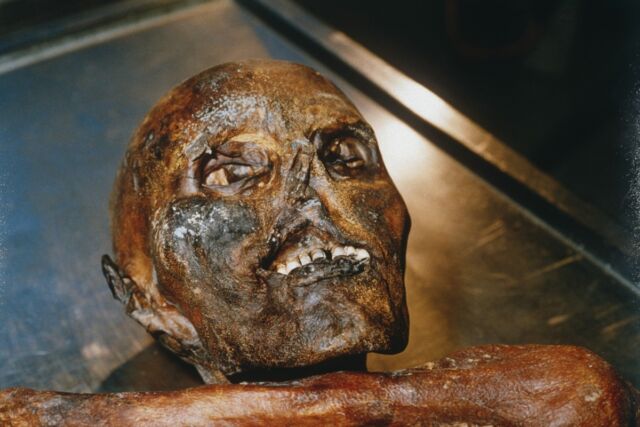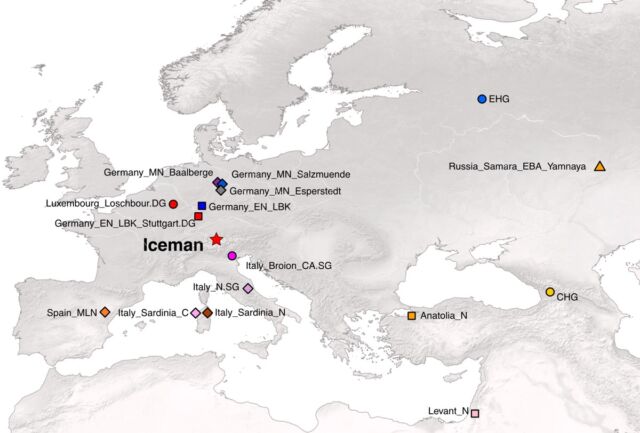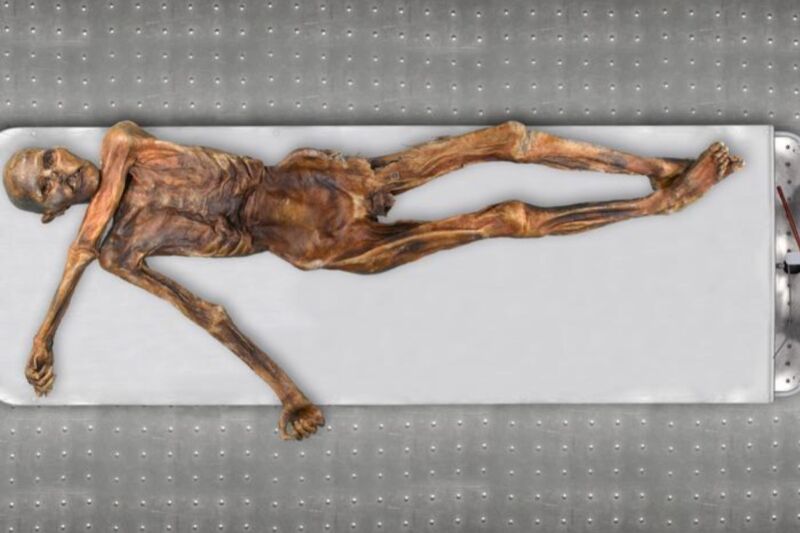In 1991, a group of hikers found the mummified remains of Ötzi the Iceman emerging from a melting glacier in the Alps—likely murdered, judging by the remains of an arrowhead lodged in his shoulder. The mummy's genome was first sequenced in 2012, whereby the world learned that he likely had brown eyes, type O blood, blocked arteries, Lyme disease, and lactose intolerance. That first genetic analysis also determined that Ötzi was descended from Steppe Herders hailing from Eastern Europe who migrated to the region some 4,900 years ago.
However, according to a recent paper published in the journal Cell Genomics, Ötzi actually has more common ancestry with early farmers who migrated from Anatolia roughly 8,000 years ago, and the earlier findings were the result of modern DNA contaminating the original sample. The authors also used the latest advanced sequencing technology to paint a more accurate picture of the Iceman’s appearance and other genetic traits. Most notably, his skin was probably much darker than previously assumed, and he was likely bald, or nearly so, when he died.
As previously reported, archaeologists have spent the last 30 years studying the wealth of information about Copper Age life that Ötzi brought with him into the present. Studies have examined his genome, skeleton, last meals, tattoos, and the microbes that lived in his gut. For instance, in 2016, scientists used DNA sequencing to identify how Ötzi's clothing was made and found that most of it was made from domesticated cattle, goats, and sheep, although his hat was made from brown bear hide and his quiver from a wild roe deer.
A 2018 paper took a closer look at Ötzi's tools, revealing details of his lifestyle, his last days, and the trade networks that linked far-flung Alpine communities. Also in 2018, scientists analyzed the remnants of Ötzi's last meal in his stomach, concluding that he ate a hearty mountaineer’s high-fat diet of red deer, wild goat, and whole-grain einkorn wheat—but he may also have accidentally eaten toxic ferns.
Given the extraordinary preservation of the body, the accepted interpretation is that Ötzi fled from the valley after being attacked and froze to death in the gully where his mummified remains were found. His body and the tools he brought with him were quickly buried beneath the ice and remained frozen under a moving glacier for the next 5,300 years. The gully protected the remains from damage by the glacier.
But in 2022, scientists suggested that Ötzi died elsewhere on the mountain and that normal environmental changes gradually moved his remains down into the gully. Further, for the first 1,500 years after his death, Ötzi's remains likely thawed and refroze at least once and quite possibly several times. That means it's much more likely that another ice mummy could be discovered, since no extraordinary circumstances are required to explain Ötzi's preservation.

The mummified corpse of Ötzi the Iceman, discovered in 1991.
Leopold Nekula/Sygma/Getty Images
Most relevant to this latest study is the 2012 genomic analysis, particularly the finding that Ötzi's ancestors were Steppe Herders. Johannes Krause of the Max Planck Institute for Evolutionary Anthropology in Leipzig, who co-authored this latest paper, told New Scientist that it had always been a "weird" result since Steppe Herders didn't arrive in the region until after the Iceman died. Suspecting the sample had been contaminated with modern European DNA, Krause and colleagues re-sequenced Ötzi's genome using fresh samples taken from the left iliac bone and surrounding tissue—the same place from which the 2012 samples had been collected.
The team found that the 2012 data set had almost 10 percent contamination from modern DNA. And Anatolian farmers accounted for 90 percent of the Iceman's ancestry, with early hunter-gatherers making up the remaining 10 percent. “We were very surprised to find no traces of Eastern European Steppe Herders in the most recent analysis of the Iceman genome; the proportion of hunter-gatherer genes in Ötzi’s genome is also very low," said Krause. "Genetically, his ancestors seem to have arrived directly from Anatolia without mixing with hunter-gatherer groups."

Geographic location of the Iceman and analyzed published ancient Western Eurasian groups.
K. Wang et al., 2023
Past re-creations of Ötzi's likeness depict him with a full head of long, thick hair, but this is probably also inaccurate, according to the authors, since their analysis showed a gene variant associated with a tendency toward male pattern baldness. There were also genetic variants present indicating an increased risk of obesity and Type 2 diabetes, but the authors maintain that Ötzi’s lifestyle was probably healthy enough that those risk factors never materialized.
Ötzi is also often depicted as having lighter skin pigmentation, even though studies in the 1990s showed evidence of melanin pigment in his skin, suggestive of a darker skin tone. The new analysis confirms that, based on 154 sites on the genome relating to darker pigmentation. “It's the darkest skin tone that has been recorded in contemporary European individuals,” said co-author Albert Zink, an anthropologist who heads the Eurac Research Institute for Mummy Studies in Bolzano and also co-authored the 2012 study. “It was previously thought that the mummy's skin had darkened during its preservation in the ice, but presumably what we see now is actually largely Ötzi's original skin color. Knowing this, of course, is also important for the proper conservation of the mummy.”
The authors concede some limitations of their study, most notably that a single individual (Ötzi) provides a very limited picture in terms of the population history of the region in which he was found. Also, they add, "We caution that the actual phenotype is a combined effect from genetic mechanism and environment exposures through gene-by-environment interaction," the authors wrote, noting that there could be multiple variants that affect complex traits like male pattern baldness and skin pigmentation. However, their direct observation of the actual mummy allowed them to corroborate their phenotype predictions gleaned from the new genomic analysis.
Cell Genomics, 2023. DOI: 10.1016/j.xgen.2023.100377 (About DOIs).



3175x175(CURRENT).thumb.jpg.b05acc060982b36f5891ba728e6d953c.jpg)


Recommended Comments
There are no comments to display.
Join the conversation
You can post now and register later. If you have an account, sign in now to post with your account.
Note: Your post will require moderator approval before it will be visible.